Abstract
To address the world’s ongoing environmental challenges, 193 countries have committed to 17 sustainable development goals (SDGs) concerning the economy, society, and the environment. However, there are gaps in our understanding of forests and forestry support SDGs. Through a systematized review, we identified which SDGs are relevant to forests and forestry at the target level, along with their interactions (synergies or tradeoffs). In addition, a bibliometric analysis of 377 papers was conducted worldwide between 2015 and 2020, to elucidate the status and development trends of SDG research related to forests and forestry in this study. The research results show that: (1) 11 SDGs and 19 targets are related to forests and forestry, and 47 are interactions between SDG15 and other targets, including 35 synergy effects and 12 tradeoff effects. (2) The USA is the highest publication output country, while the Chinese Academy of Sciences is the highest publication output institution, and Jianguo Liu of the University of Michigan is the highest publication output author. (3) The keyword co-occurrence analysis results show that the research hotspots mainly focused on the impacts of and responses to climate change, biodiversity conservation, land resource protection and management, remote sensing, the impacts of deforestation, and the promotion of sustainable development through governance. (4) The co-citation results reveal the existence of nine research themes: human well-being, food security, land use, land productivity, land tenure, tree loss, simulation models, criteria, and resilience.
1. Introduction
Ecosystem services support human well-being, which is an endpoint and a core goal of sustainable development [1,2,3,4]. Forest ecosystems are critical for supporting human well-being because they fulfill functions such as water source conversion, soil retention, carbon fixation, oxygen release, air purification, forest products production, biodiversity support, forest recreation, and so on [5,6,7,8,9,10]. Forestry involves the management, protection, utilization, scientific research, practice, and planting of forests. Forestry, broadly, involves the protection of ecological environments to maintain an ecological balance and the management and protection of forests to produce wood and other forest products; forest characteristics play a protective role. The purpose of forestry includes the rational development and utilization of forests to improve ecosystem services and human well-being and promote sustainable development [11,12]. In 1987, the World Environment and Development Committee published the report, “Our Common Future” and clarified the concept of “sustainable development”. Sustainable development is defined as meeting the needs of the present without compromising the ability of future generations to meet their own needs [13]. Subsequently, with increasing concern for sustainable development, the concept of sustainable development is constantly improving and becoming clearer [14]. Thanks to the joint efforts of the world’s nations, humans have made substantial achievements in many aspects of hunger and poverty and have improved environmental quality but still face grim development problems [15,16]. To guide sustainable global development after the expiry of the Millennium Development Goals and to cope with increasing challenges, the United Nations adopted the 2030 Sustainable Development Agenda in September 2015. The 2030 Sustainable Development Agenda clarifies the 17 Sustainable Development Goals (SDGs) and 169 targets to guide sustainable global development. These SDGs involve all aspects of society, the economy, and the environment, aiming to protect, restore, and promote the ecosystem while achieving human well-being [17].
As the main body of terrestrial ecosystems, forest ecosystems play an important role in supporting the completion of SDGs. The sustainable development of forestry and improvement in the service functions of forest ecosystems conforms to the established SDGs. For instance, SDG15 (life on land) directly involves forestry and clearly states the goal is to “protect, restore, and promote the sustainable use of terrestrial ecosystems; sustainably manage forests; combat desertification; halt and reverse land degradation, and halt biodiversity loss”. Moreover, forest ecosystems can conserve water; this function is directly related to SDG6 (clean water and sanitation) [18,19]. The capture and storage of carbon by forests is conducive to adapting to and mitigating global climate change, contributing to SDG13 (climate action) [20]. In addition, the material products provided by forests, including wood, food, biofuel, etc., can support SDG1 (to end poverty) [21,22], are conducive to ensuring food security to support SDG2 (zero hunger), and allow sustainable and modern energy alternatives to reach SDG7 (affordable and clean energy) [23,24]. Simultaneously, forestry production and forest tourism provide employment opportunities, thus supporting SDG8 (decent work and economic growth) to a certain extent [25]. However, the relationships between different SDGs are complex. Changes in specific SDGs impact other relevant SDGs, and these feedback effects may be positive or negative. For instance, increasing the demand for food or bioenergy provided by forests increases the pressure on forest ecosystems [26,27,28]. Therefore, when studying forestry-related SDGs, it is necessary to comprehensively consider the relationship between different SDGs and balance forest sustainability with human needs.
The existing research has used literature reviews to summarize the relationship between specific fields and SDGs [29,30]. In recent years, many studies of sustainable development have adopted bibliometrics because of their effectiveness in showing the general state of the art and changing the trajectory of a research field [31,32,33,34,35]. However, research on forestry and SDGs is lacking. Although forestry is closely related to SDGs, there are still many gaps in understanding the relationship between them. These gaps include what targets and SDGs are related to forests and forestry, the relationship between these SDGs, and the research status of forestry and SDGs. To fill the gap mentioned above, this study reviewed the literature on forestry and forest research related to the SDGs and employed bibliometric analysis for the literature on forestry and forest research, related to the SDGs, as published on the Web of Science core collection between 2015 and 2020. The aims of this study were to: (1) analyze which SDGs and targets are relevant to forestry and forests, assessing the interaction of these SDGs and targets; (2) identify the research characteristics of SDGs related to forests and forestry, including the number of publications, journals, and the cooperative network among representative countries, institutions, and authors in this field; (3) investigate the hot topics and variation research trends of research on SDGs, related to forests and forestry.
2. Methodology
This study is divided into three sections; the first section identifies what SDGs and targets are relevant to forests and forestry through a literature review. The second section assesses the interaction of these SDGs and targets, through the seven-point-scale framework [36]. The third section analyzes the status and development trend of SDG research related to forests and forestry since the publication of the SDG, through bibliometric methods. The specific workflow of Section 1 and Section 3 in this study are shown in Figure 1. For details on the Section 2, see methodology 2.2.
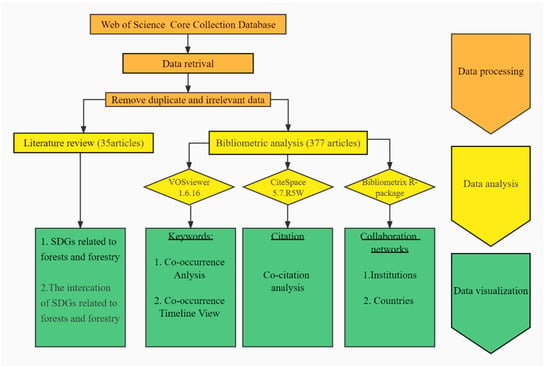
Figure 1.
Research framework design.
2.1. Identify SDGs and Targets Relevant to Forestry and Forests
The SDGs and the targets relevant to forestry and forests are determined based on the literature and expert judgment. Each target of the 17 SDGs is a sentence describing the criteria for achieving sustainable development by 2030. Keywords were extracted from the sentences of targets and matched with “forest” and “forestry” to retrieve the relevant literature. The research method and the keywords for each specific target reference the research of Wang et al.; keywords for each target are provided in Table S2 of the Supplementary Material [37]. A detailed description of how forests and forestry affect the target of SDGs is in Table S1 in the Supplementary Materials.
2.2. Assessing the Relationship between SDG15 and Other SDGs
The interactions (synergistic or tradeoffs) of the targets’ relevant forest and forestry topics are assessed in this study. Those interactions with the relevant targets are assessed for the seven-point-scale framework of Giggs et al. The interactions are divided into seven levels: (+3) indivisible, (+2) reinforcing, (+1) enabling, (0) consistent, (−1) constraining, (−2) counteracting, and (−3) canceling. The positive level refers to synergies, the negative levels refer to tradeoffs, and zero refers to neutrality. The seven levels of the interactions are defined and explained in Table S3 in the Supplementary Materials.
2.3. Bibliometric Analysis
The Web of Science is considered the primary quality-oriented database and can provide a more standardized record for retrieving research literature in global multidisciplinary fields [38]. Therefore, we used the Institute for Scientific Information (ISI) Web of Science Core Collection (WoSCC) database as the data source for this study. We employed the following string: (“Sustainable Development Goals*” OR SDG*) AND (forestry* OR forest* OR ecosystem* OR “ecological system”) to search for relevant documents in the WoSCC. We filtered the results with the following criteria: published within the 2015–2020 timespan, published in English, and published as an article document type. The initial literature search identified 678 published studies. These documents were further filtered by reading them; ultimately, 377 related documents were selected. The retrieved literature records were downloaded and saved as a plain text file in the “full record and cited references” format, for use as sample data in this paper. Bibliometrics applies statistical methods to analyze the academic literature quantitatively and can effectively describe the scientific activity in a particular field of research [32,39]. CiteSpace is a free software package that is commonly used for bibliometric analyses and was developed by Chen [40]; in this study, version 5.7.R5W was used. VOSviewer is a free software package, developed by Van Eck and Waltman [41]; version 1.6.16 was used in this study. The Bibliometrix R-package (RStudio v.3.4.1 software) is an application providing a web interface for Bibliometrix [42]. We analyzed the bibliometric data using the following methods: (1) building collaboration networks of institutions and countries by R Bibliometrix. In this study, “China” refers to the Chinese mainland only; (2) analyzing the co-occurrence of keywords, obtaining a keyword co-occurrence timeline view using VOSviewer; (3) a co-citation analysis in Citespace.
3. Results
3.1. SDGs and Targets Are Relevant to Forestry and Forests
The research results show that there are 11 SDGs and 19 targets related to forestry and forests. We believe that SDG15 is particularly important for forests and forestry. There are five targets of SDG15 related to forests and forestry, of which 15.1 and 15.2 explicitly refer to the protection and management of forests. Target 6.6 is about protecting and restoring water-related ecosystems, including forest ecosystems, also directly referring to forests and forestry (Figure 2 and Table S1 in the Supplementary Materials). It shows that the contribution of forestry and forests is not limited to environment-related goals but also contributes to other goals related to society and the economy.
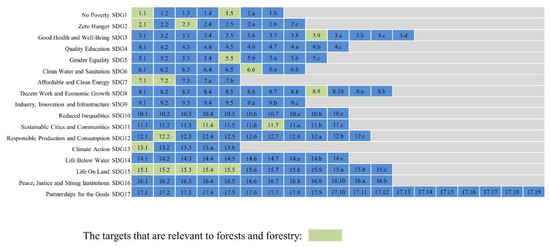
Figure 2.
The Sustainable Development Goals (SDGs) and the targets that are relevant to forests and forestry.
3.2. Interaction between SDG15 and Other SDGs
Because SDG15 is closely related to forests and forestry, this study uses SDG15 to represent forests and forestry and assess the interaction of other targets. This study identified 47 interactions between the targets of SDG15 and other targets, including 35 synergistic effects and 12 tradeoff effects (Figure 3 and Table S3 in the Supplementary Materials). Tradeoff interactions have been identified between SDG15 and SDG1 (no poverty), SDG2 (zero hunger), and SDG7 (affordable and clean energy). However, SDG15 may be a synergy or a tradeoff with other goals (SDG1, SDG2, SDG7), as shown in Figure 3. A reasonable overall arrangement of the objectives is the key to promoting synergies and reducing tradeoffs.
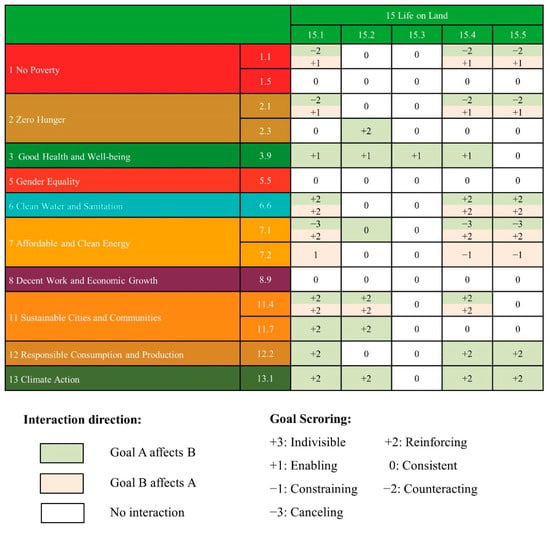
Figure 3.
Interactions between SDG15 and other SDGs at the target level. Goal A represents SDG15 and Goal B represents other SDGs related to forestry.
3.3. Research Characteristics of SDGs Related to Forests and Forestry
3.3.1. Source Analysis
The largest source journal is Sustainability (n = 40), followed by Ecosystem Services (n = 14) and Forests (n = 14). The number of publications obtained from the top 10 source journals was 134, accounting for 35.54% of the sample size (Table 1). The source journals mainly represented the natural sciences, such as environmental science, ecology, and forestry. This result shows that social science articles are lacking in this research field.

Table 1.
Top 10 productive journals in the research of forestry and SDGs.
3.3.2. Changes in the Annual Number of Publications
Since the 2015 Sustainable Development Goals were proposed, the number of annual publications on SDGs related to forests and forestry has been rising. Since the publication time of a paper affects the number of citations, the average number of citations cited per year was used to eliminate the influence caused by the different publication times. As shown in Figure 4, the highest number of citations was 10.83 in 2016, and the lowest value was 3.09 in 2015. The average annual citation number between 2017 and 2019 was between 6 and 8; in 2020, the number fell to 5.89. It can be seen from Figure 4 that the attention paid to this area of research, in general, is increasing year by year.
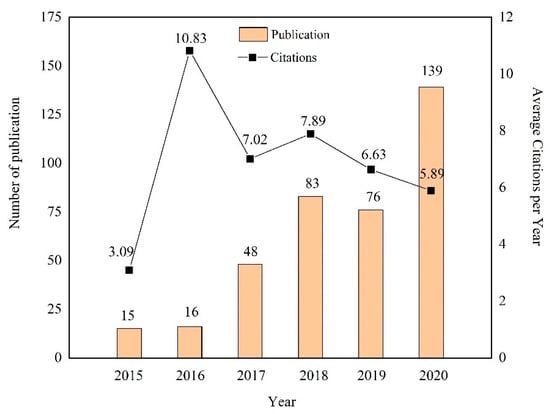
Figure 4.
The number of publications and times cited per year in 2015–2020.
3.3.3. Regional Productivity and Cooperation
We analyzed the corresponding authors to determine national cooperation in the research of SDG related to forests and forestry in different countries. As shown in Figure 5, the single-country publication (SCP) number is the total number of articles published by authors in a given country, while multiple-country publication (MCP) represents the total number of articles completed through country cooperation. The top 10 most-published countries demonstrate national cooperation in SDG research related to forests and forestry. Australia had the highest frequency of international cooperation at 77.3%, while Sweden had the lowest frequency, at 44.4%, of the top 10 countries.
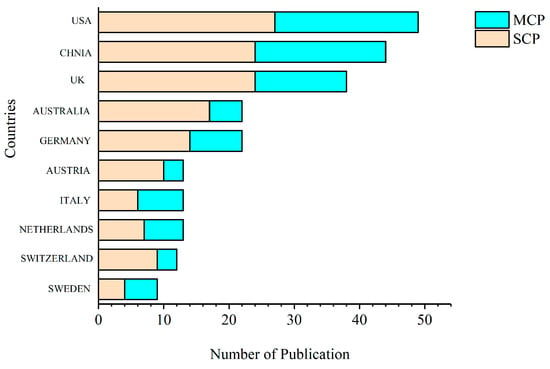
Figure 5.
Top 10 corresponding authors’ nationalities regarding the research of SDGs related to forests and forestry. SCP indicates a single-country publication, and MCP indicates a multiple-country publication.
In the current study, 377 forest ecosystem research articles involving SDGs were found to have been published in 59 countries. The USA, China, the UK, Australia, Germany, Austria, Italy, the Netherlands, Switzerland, and Sweden were the top 10 productive countries that published the most research on SDGs related to forests and forestry over the last 5 years. Among these top 10 countries, only China is a developing country, while the rest are developed countries (Table 2).

Table 2.
Countries with the highest number of publications (Top 10).
Figure 6 shows the number of articles published in each country and the level of cooperation between countries. The darker the blue color is, the more articles are published. The red line represents cooperation; the denser this line is, the closer the cooperation was. In the field of SDG-related forest and forestry international collaboration, the USA has carried out frequent cooperation with China, Australia, Canada, the UK, Germany, and the Netherlands. In addition, the European countries of the UK, France, Germany, Austria, and the Netherlands have cooperated frequently.
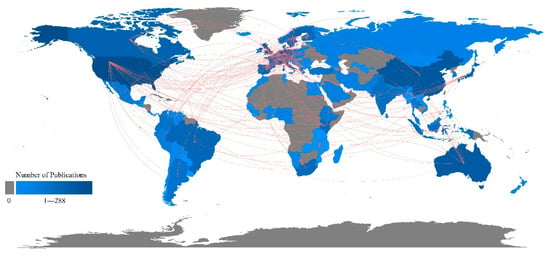
Figure 6.
The cooperation network of the most productive countries.
3.3.4. Productive Institutions and Cooperation
The institution with the largest number of studies on SDG-related forest and forestry topics during 2015–2020 was the Chinese Academy of Sciences (n = 21), followed by the Joint Research Centre of the European Commission (n = 14), Stockholm University (n = 12), the University of the Chinese Academy of Sciences (n = 11), Michigan State University (n = 10), the Center for International Forestry Research (n = 7), the University of Cambridge (n = 7), the University of Queensland (n = 7), and the University of Minnesota (n = 6) (Table 3). Figure 7 shows the cooperation relationships among the top 10 institutions with the highest number of publications.

Table 3.
Institutions with the highest number of publications (Top 10).
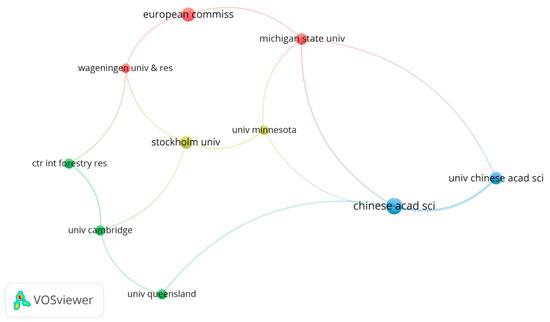
Figure 7.
The cooperation network of the most productive institution.
3.3.5. Productive Authors
In Table 4, the number of publications is listed as productivity and the number of citations is listed as the influence of the top contributing authors in SDG research related to forests and forestry research. Jianguo Liu (7), Johan Bouma (6), Luca Montanarella (5), and Pete Smith (4) were the most productive authors. The remaining authors published 3 articles each. The top three influences were Pete Smith, Luca Montanarella, and Bouma Johan, with 730, 675, and 655 total citations, respectively.

Table 4.
Most prolific authors (Top 10).
3.4. Hot Topics and Variations in the Trends of Research into SDGs Related to Forests and Forestry
3.4.1. Keyword Co-Occurrence
Keywords reveal the core content of publications and the development of research frontiers over time. The keyword co-occurrence analysis performed in this study shows that the keyword network consisted of 44 nodes and 218 links (Figure 8). The size of nodes indicates the frequency of keywords, and the thickness of links indicates the tightness between keywords. The highest-frequency keyword was “ecosystem services” (frequency = 40). The keywords with the top-ten frequencies also included “sustainability” (29), “climate change” (29), “biodiversity” (19), “remote sensing” (16), “deforestation” (14), and “land degradation” (13), “redd+”(10), “indicators” (10), “agenda 2030” (10); the subject word in the frequent keyword analysis did not include “SDGs” or “forests” (Table S7 in the Supplementary Materials). In Figure 8, different colors represent different keyword clusters.
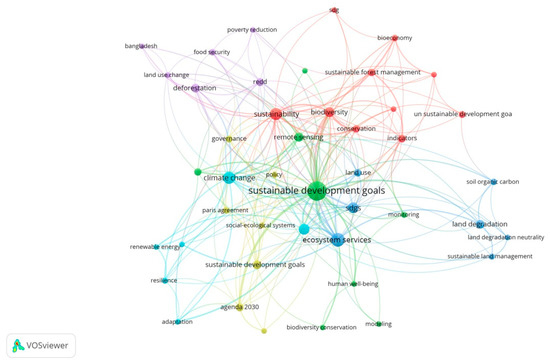
Figure 8.
Keyword co-occurrence network. The size of each keyword (node) represents the number of occurrences in the documents analyzed. The colors represent different clusters.
Publications with keywords in the sky blue cluster describe links between climate change and forest-related SDGs. The main keywords include “renewable energy,” “climate change,” “restoration,” “resilience,” and “adaptation.” These studies have focused on the impact of climate change on forest ecosystem services, such as carbon storage, thus affecting sustainable development [43,44,45]. The relationship between forestry and other sustainable development goals in the context of climate change is also discussed, such as forest protection and the mitigation of climate change synergies, along with the tradeoffs between afforestation and water supply [46].
Publications with keywords in the purple cluster were mainly related to deforestation. The main keywords included “deforestation,” “REDD+,” “land use change,” “food security,” “poverty reduction,” and “Bangladesh.” These studies mainly addressed the contradictions among forests, agriculture, urbanization, and the social economy, and explored how to weigh the interests of all parties to promote sustainable development [47]. Studies also include deforestation and how to reduce deforestation, including policies and management improvements [48].
Publications with keywords in the yellow cluster were mainly related to governance and the promotion of sustainable development through consensus and policies among governments. The main keywords in this cluster included “agenda 2030,” “community forestry,” “governance,” “Paris agreement,” “policy,” and “social-ecological systems.” The policy effectiveness evaluation, impact factor evaluation, and future scenario analysis to promote SDGs are research issues of concern in this cluster [49,50,51].
Publications with keywords in the dark blue cluster were mainly related to land degradation and mainly included “land degradation,” “land degradation neutrality,” “land use,” “soil organic carbon,” and “sustainable land management.” Preventing land degradation is the goal of SDG15, and our results show that monitoring and assessing land degradation conditions is a research hotspot. The studies covered land degradation assessment, land degradation cause research, prediction of land degradation, and measures to improve land degradation [52,53,54,55].
Publications with keywords in the green cluster were mainly related to remote sensing and included “human well-being,” “machine learning,” “modeling,” “monitoring,” “protected areas,” “remote sensing,” and “biodiversity conservation.” The techniques to monitor the SDG-related indicators are an indispensable step to achieving SDG. The studies in this cluster explore how to combine remote sensing to effectively monitor SDG-related indicators, such as land-use change, forest area, species distribution, forest carbon stocks, etc. [56,57].
The keywords in the red cluster were mainly related to biodiversity and included “biodiversity,” “conservation,” “indicators,” “protected area,” “sustainability,” “sustainable forest management bioeconomy,” and the “circular economy”. The SDGs cover biodiversity conservation, and it is reasonable that the study of biodiversity and biodiversity conservation status assessment is a hot topic in this research area [58,59]. At the same time, biodiversity conservation may conflict with human needs, so evaluating the relationship between biodiversity conservation and human needs and how to balance the two are research hotspots [60]. In addition, we simulate changes in biodiversity under different scenarios to explore sustainable development paths in terms of the relevant research questions [61].
VOSviewer software cannot recognize different expression forms of the same word. Thus, the UN Sustainable Development Goals, Sustainable Development Goals, SDGs, and Sustainable Development Goals in Figure 8, all represent the subject words “Sustainable Development Goals.” Visually (Figure 8), the biggest node is the subject word “SDGs” followed by “ecosystem service” and the two keywords are close together. It shows that ecosystem services are important for the SDGs because forests support the SDGs by providing ecosystem services. The red cluster (biodiversity) and purple cluster (deforestation) are adjacent, indicating that research on deforestation and biodiversity is usually related to deforestation.
3.4.2. Keywords Timeline Visualization
In Figure 9, the average publication years of all keywords are identified by color. Among them, yellow represents more recent keywords, indicating that these keywords have become hot topics in the research into forestry and SDGs in recent years. In contrast, the purple words are slightly less popular. Green indicates that the average publication year of the keyword is in the middle and that the corresponding keyword has thus always been a key point of research in this field.
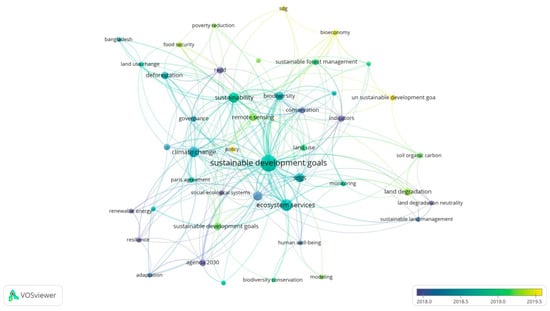
Figure 9.
Keywords co-occurrence timeline view. The size of each keyword (node) represents the number of occurrences in the documents analyzed. Colors represent different clusters. The color represents the year when the keyword first appeared, and the color from blue to yellow represents early to late.
The 2030 agenda is the beginning of SDGs, so it is one of the earliest keywords. As shown in Figure 9, some important keywords in the field of SDG-related forest and forestry research began to appear over time, including “ecosystem services,” “biodiversity,” “climate change,” and “deforestation.” Recent keywords include “bioeconomy,” “food security,” and “policy.” According to the result of the keywords co-occurrence timeline view, from the keywords of the original concept of SDGs, more turned to concrete realizations along the way.
3.4.3. Analysis Co-Citation Reference
The co-citation reference collection results were clustered into nine classes using the log-likelihood ratio (LLR) algorithm (Figure 10). The quality of the cluster structure was measured using the modularity (Q) and silhouette values. Q values of greater than 0.3 and silhouette coefficients of greater than 0.5 indicated reasonable data clustering (Chen 2006). The silhouette coefficients of the nine clusters exceeded 0.7, indicating that each of these clusters was homogeneous. The nine salient clusters were sorted by the number of members (Table S4 in the Supplementary Materials). Representative publications were identified as the documents with the greatest co-citation frequency in each cluster; these documents influence the labeling of each cluster to reveal the research frontier. The results show that the reference collection could be divided into nine categories: human well-being, food security, land use, land productivity, land tenure, tree loss, simulation models, criteria, and resilience. Human well-being shows the largest number of clusters in Figure 9, which is consistent with the core purpose of sustainable development. The conflicts between forestry and other SDGs have attracted much attention. These conflicts can cause competition for land resources and the driving of economic interests.
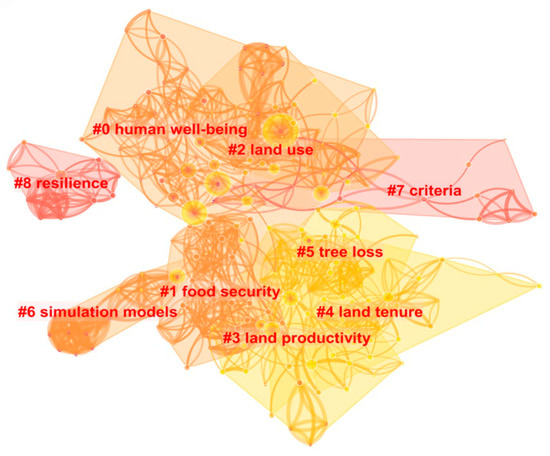
Figure 10.
Clustering analysis of co-cited references.
4. Discussion
Our research results show that SDGs are inseparable from forests and forestry. There are 19 targets of the 11 SDGs relating to forests and forestry, which targets SDGs 15.1 and 15.2, along with the SGD 6.6 direct reference to forests and forestry. However, forests and forestry affect other targets, mainly in an indirect role; for example, forests may support target 2.1, improving agricultural productivity by improving environmental quality [62,63]. This indirect contribution is often easily underestimated. Therefore, it is necessary to determine which targets can be supported by forests and forestry in what ways, which is the purpose of this study. Thirty-five synergistic effects were found between SDG15 and other SDGs, which, while pursuing the realization of SDG15, can promote the realization of multiple SDGs. The core of SDG15 is to protect and restore the forest ecosystem, which is consistent with SDG6 (clean water and sanitation), SDG11 (sustainable cities and communities), and SDG13 (climate action). The forest itself is an important water source, a carbon pool, and part of a sustainable city [64,65,66]. Tradeoff effects occur between SDG15 (life on land) and SDG1 (no poverty), SDG2 (zero hunger), and SDG7 (affordable and clean energy). The potential tradeoffs occur with the goals related to economic and social levels, which aim to ensure food security, develop renewable energy, and reduce poverty. Forest protection and sustainable management may conflict with the above goals because of land and economic interest, and so on. For example, agricultural land expansion, mining, excessive access to forest products, and infrastructure construction, including renewable energy production facilities, will cause the destruction or occupation of forests [67,68,69,70]. Conversely, forest protection and sustainable forest management may hinder them. Therefore, how to balance the relationship between the achievement of forest-related SDGs and human needs is an important research topic in this research field.
Forest ecosystems are closely related to SDGs, and our results show that the number of publications on forestry and SDGs increased from 2015 to 2020, suggesting that the research field is receiving more attention. SDGs benefit from ecosystem protection, restoration, and sustainable use [71,72]. For the forestry sector, the supply level of forest ecosystem services is the key to supporting SDGs. Therefore, the keywords “ecosystem services” are always a critical topic in the research of SDGs related to forestry and forests. Regarding the average annual number of citations, Keesstra’s article [73], which discussed how soil science can help to reach the recently adopted SDGs most effectively, received a high number of citations after its publication in 2016, when only 16 articles were published. Therefore, the average annual number of citations in 2016 was the highest. The number of articles published in 2020 was the highest, but many articles have low citations, resulting in a lower number of average annual citations in 2020.
Regarding the research topic, this study identified the main research hotspots through a keyword co-occurrence analysis. These hotspots mainly focused on the impacts of and responses to climate change, biodiversity conservation, land resource protection and management, remote sensing, deforestation, and SDG promotion through governance. The results of the analysis of the co-cited reference also cover these research topics. In terms of climate change, tackling climate change is the main aim of SDG 13. The forestry sector plays an irreplaceable role in climate change mitigation. Sustainable forest management and climate change mitigation share common approaches, and promoting synergistic interaction between goals is key to policy development. The published articles on climate change mainly addressed adapting to climate change and the role played by forests in climate change mitigation measures [74]. The development of renewable energy is an effective way to mitigate climate change and promote sustainable development. However, the development of renewable energy may negatively impact other SDGs, such as the land conflict between renewable energy facilities and biodiversity conservation areas [75,76,77]. Therefore, research is being conducted to evaluate the impacts of the development of renewable energy on the functions of forest ecosystems [78,79,80]. In terms of deforestation, forest deforestation hinders sustainable forestry development and is an important topic in forestry and SDG research. The keyword “REDD+” (reducing emissions from deforestation and forest degradation) relates to forest degradation. REDD+ aims to reduce global greenhouse gases (GHGs) in the atmosphere while promoting forest conservation, along with the sustainable management of forests and carbon stocks by reducing deforestation [81]. Therefore, the research has addressed the tradeoffs among REDD+ projects, food security, land use, and poverty reduction [82]. Deforestation is threatening the health of forest ecosystems, and human factors are one of the significant causes of deforestation. The root cause could be poverty, urban expansion, and other social problems. Therefore, it is necessary to integrate social science to address these problems, which is also the development direction of this research field. Remote sensing has been widely used in forestry and SDG research as a research method to monitor and evaluate forest ecosystem services and, thus, track sustainable development target processes, such as land use changes, land degradation, and biodiversity conservation [83,84,85]. In terms of biodiversity and land resources, preventing and reversing land degradation and halting biodiversity losses are the purposes of SDG 15. Therefore, determining how to protect biodiversity and curb land degradation through forest management has attracted much attention. In terms of governance, achieving the established SDGs will require efforts at different levels, including at the global, national, and individual levels. For example, the “Paris Agreement” and “2030 Agenda” keywords are representative of global-level governance programs.
As determined from the timeline, the “2030 Agenda” was one of the earliest keywords published. Subsequently, the ecosystem service functions related to SDGs were referred to as the research focus, and several research directions, such as adaptation to climate change, biodiversity conservation, and deforestation reductions, were established. On this basis, the literature began to link specific SDG targets, such as poverty reduction, food security, and land degradation, to forests. In response to the literature addressing how to promote SDG implementation, some new research directions have arisen, such as the development of the bioeconomy and policy research aiming to promote SDGs. To sum up, the research on monitoring and implementation approaches at the target level is a crucial research direction in the future. As can be seen from the results of the bibliometric analysis in this study, forests and forestry are related to multiple SDGs. The published research covers many SDGs, including those corresponding to the protection of forest resources, the prevention of land degradation and biodiversity loss, the mitigation of climate change, the reduction of poverty, the promotion of food security, and the promotion of renewable energy development. However, some SDGs are less concerned even though they are closely related to forest ecosystems. For example, forest tourism can promote SDG 8, which aims to create employment through sustainable tourism [86]. Forests have the effect of cultivating and purifying water, thus contributing to SDG 6 [87].
5. Limitations
This study provides new perspectives for forestry and SDG research, but there are still limitations. First, assessing which SDGs are relevant to forests and forestry and their interaction is based on existing literature and expert judgment. Such an approach is subjective; however, it also provides an opportunity for researchers to refine those results, based on new research literature and accumulated expertise. Second, bibliometric analysis in this study selected only articles in English, and all of the literature was obtained from the Web of Science Core Collection database, which also has its limitations. SDGs are significant political issues that are not limited to scientific research. Therefore, a systematized analysis of policy outlines and assessment reports on SDGs, especially those from authoritative international organizations, is necessary to overcome the lack of data due to language and database limitations. At the same time, while the study of SDGs involves both natural science and social science, insufficient analyses of the social sciences have been performed; thus, this gap in the literature will be the direction of future research.
6. Conclusions
In this work, we identify which SDGs are related to forests and forestry, which can support the SDGs at the target level, and in what ways. In addition, we assess the relationships between these SDGs. Meanwhile, a comprehensive bibliometric analysis of SDG research related to forests and forestry was carried out, based on 377 publications retrieved from the Web of Science. The number of publications on forestry research and SDGs has shown an increasing trend since 2015, with the fastest growth recorded in 2020. Except for China, the top 10 most productive countries were all developed countries. This shows that this research field is mainly concerned with developed countries, even if the SDGs are intended for all countries in the world.
Furthermore, the keyword co-occurrence analysis described the main key research themes: ecosystem services, biodiversity, conservation, climate change, and management. While earlier keywords referred to the forest ecosystem services related to SDGs, recent research keywords included specific SDGs. Finally, the nine largest clusters were obtained by a co-citation analysis, and the most critical cluster concerned human well-being. This is in accordance with the core intention of sustainable development, which is to promote human well-being. Sustainable development is a complex issue involving the economy, society, and the environment. Hence, it also needs the support of integrated sociocultural studies in this research field, and should reasonably balance different sustainable development goals, reduce conflicts, and promote coordinated development, which could help support policymaking.
Supplementary Materials
The following supporting information can be downloaded at: https://www.mdpi.com/article/10.3390/f13111960/s1, Table S1: Sustainable development goals (SDGs) and the targets that are relevant to forestry; Table S2. Keywords of the sustainable development goals (SDGs) and targets; Table S3: The seven-point-scale framework of Griggs et al. to analyze the relationship between SDGs; Table S4: Interactions between SDG15 and other SDGs at target level; Table S5: Top 10 corresponding authors’ nationalities on SDGs studies related to forests and forestry; Table S6: Top 10 Frequency of national cooperation; Table S7: High-frequency keywords; Table S8: Reference clustering; Table S9 The top 10 highly-cited references.
Author Contributions
Conceptualization, Z.M. and J.L.; methodology, Z.M.; software, Z.M.; data curation, Z.M., C.H., J.H. and T.L.; writing—original draft preparation Z.M.; writing—review and editing, Z.M., J.L., C.H., J.H. and T.L.; visualization, Z.M.; project administration, J.L.; funding acquisition, J.L. All authors have read and agreed to the published version of the manuscript.
Funding
This research was supported by the Projects of National Forestry and Grassland Administration: Technical support for UNFI Implementation in China.
Institutional Review Board Statement
Not applicable.
Informed Consent Statement
Not applicable.
Data Availability Statement
The datasets of this study are available in the Web of Science repository (http://apps.webofknowledge.com/), accessed on 2 August 2021.
Conflicts of Interest
The authors declare no conflict of interests.
References
- Costanza, R.; d’Arge, R.; De Groot, R.; Farber, S.; Grasso, M.; Hannon, B.; Limburg, K.; Naeem, S.; O’Neill, R.V.; Van Den Belt, M. The value of the world’s ecosystem services and natural capital. Nature 1997, 387, 253–260. [Google Scholar] [CrossRef]
- Costanza, R.; de Groot, R.; Sutton, P.; Van der Ploeg, S.; Anderson, S.J.; Kubiszewski, I.; Farber, S.R.; Turner, R.K. Changes in the global value of ecosystem services. Glob. Environ. Chang.-Hum. Policy Dimens. 2014, 26, 152–158. [Google Scholar] [CrossRef]
- Summers, J.K.; Smith, L.M. The Role of Social and Intergenerational Equity in Making Changes in Human Well-Being Sustainable. Ambio 2014, 43, 718–728. [Google Scholar] [CrossRef] [PubMed]
- Wang, B.J.; Tang, H.P.; Xu, Y. Integrating ecosystem services and human well-being into management practices: Insights from a mountain-basin area, China. Ecosyst. Serv. 2017, 27, 58–69. [Google Scholar] [CrossRef]
- Liu, N.; Caldwell, P.V.; Dobbs, G.R.; Miniat, C.F.; Bolstad, P.V.; Nelson, S.A.C.; Sun, G. Forested lands dominate drinking water supply in the conterminous United States. Environ. Res. Lett. 2021, 16, 84008. [Google Scholar] [CrossRef]
- Poppy, G.M.; Chiotha, S.; Eigenbrod, F.; Harvey, C.A.; Dawson, T.P. Food security in a perfect storm: Using the ecosystem services framework to increase understanding. Philos. Trans. R. Soc. B Biol. Sci. 2014, 369, 20120288. [Google Scholar] [CrossRef]
- Pan, Y.; Birdsey, R.A.; Fang, J.; Houghton, R.; Kauppi, P.E.; Kurz, W.A.; Phillips, O.L.; Shvidenko, A.; Lewis, S.L.; Canadell, J.G.; et al. A large and persistent carbon sink in the world’s forests. Science 2011, 333, 988–993. [Google Scholar] [CrossRef]
- Qi, W.H.; Li, H.R.; Zhang, Q.F.; Zhang, K.R. Forest restoration efforts drive changes in land-use/land-cover and water-related ecosystem services in China’s Han River basin. Ecol. Eng. 2019, 126, 64–73. [Google Scholar] [CrossRef]
- Díaz, S.; Demissew, S.; Carabias, J.; Joly, C.; Lonsdale, M.; Ash, N.; Larigauderie, A.; Adhikari, J.R.; Arico, S.; Zlatanova, D. The IPBES Conceptual Framework—Connecting nature and people. Curr. Opin. Environ. Sustain. 2015, 14, 1–16. [Google Scholar] [CrossRef]
- Getzner, M.J.; Meyerhoff, J. The Benefits of Local Forest Recreation in Austria and Its Dependence on Naturalness and Quietude. Forests 2020, 11, 326. [Google Scholar] [CrossRef]
- Helms, J.A. Forest, forestry, forester: What do these terms mean? J. For. 2002, 100, 15–19. [Google Scholar]
- Baumgartner, R.J. Sustainable Development Goals and the Forest Sector A Complex Relationship. Forests 2019, 10, 152. [Google Scholar] [CrossRef]
- WCED (World Commission on Environment and Development). Our Common Future; Oxford University Press: Oxford, UK, 1987. [Google Scholar]
- Schmidt-Traub, G.; Kroll, C.; Teksoz, K.; Durand-Delacre, D.; Sachs, J.D. National baselines for the Sustainable Development Goals assessed in the SDGIndex and Dashboards. Nat. Geosci. 2017, 10, 547–555. [Google Scholar] [CrossRef]
- Cuenca-Garcia, E.; Sanchez, A.; Navarro-Pabsdorf, M. Assessing the performance of the least developed countries in terms of the Millennium Development Goals. Eval. Program Plan. 2019, 72, 54–66. [Google Scholar] [CrossRef] [PubMed]
- Lomazzi, M.; Borisch, B.; Laaser, U. The Millennium Development Goals: Experiences, achievements and what’s next. Glob. Health Action 2014, 7, 23695. [Google Scholar] [CrossRef] [PubMed]
- UN (United Nations). Sustainable Development Goals: 17 Goals to Transform Our World. 2015. Available online: http://www.un.org/sustainabledevelopment/sustainable-development-goals/ (accessed on 2 August 2021).
- Ferraz, S.F.B.; Lima, W.; Rodrigues, C.B. Managing forest plantation landscapes for water conservation. For. Ecol. Manag. 2013, 301, 58–66. [Google Scholar] [CrossRef]
- Caglayan, I.; Yesil, A.; Kabak, O.; Bettinger, P. A decision making approach for assignment of ecosystem services to forest management units: A case study in northwest Turkey. Ecol. Indic. 2021, 121, 107056. [Google Scholar] [CrossRef]
- Lin, B.Q.; Ge, J.M. Carbon sinks and output of China’s forestry sector: An ecological economic development perspective. Sci. Total Environ. 2019, 655, 1169–1180. [Google Scholar] [CrossRef]
- Sunderlin, W.D.; Angelsen, A.; Belcher, B.; Burgers, P.; Nasi, R.; Santoso, L.; Wunder, S. Livelihoods, forests, and conservation in developing countries: An Overview. World Dev. 2005, 33, 1383–1402. [Google Scholar] [CrossRef]
- Angelsen, A.; Jagger, P.; Bigumira, R.; Belcher, B.; Hogarth, N.J.; Bauch, S.; Börner, J.; Smith-Hall, C.; Wunder, S. Environmental Income and Rural Livelihoods: A Global-Comparative Analysis. World Dev. 2014, 64, S12–S28. [Google Scholar] [CrossRef]
- Otavio, C.; Cherubini, F. Contribution of jet fuel from forest residues to multiple Sustainable Development Goals. Nat. Sustain. 2018, 1, 799–807. [Google Scholar]
- Blair, M.J.; Gagnon, B.; Klain, A.; Kulisic, B. Contribution of Biomass Supply Chains for Bioenergy to Sustainable Development Goals. Land 2021, 10, 181. [Google Scholar] [CrossRef]
- Lippe, R.S.; Cui, S.N.; Schweinle, J. Estimating Global Forest-Based Employment. Forests 2021, 12, 1219. [Google Scholar] [CrossRef]
- Ernst, C.; Mayaux, P.; Verhegghen, A.; Bodart, C.; Christophe, M.; Defourny, P. National forest cover change in Congo Basin: Deforestation, reforestation, degradation and regeneration for the years 1990, 2000 and 2005. Glob. Change Biol. 2013, 19, 1173–1187. [Google Scholar] [CrossRef] [PubMed]
- Danielsen, F.; Beukema, H.; Burgess, N.D.; Parish, F.; Brühl, C.A.; Donald, P.F.; Murdiyarso, D.; Phalan, B.; Reijnders, L.; Struebig, M.; et al. Biofuel plantations on forested lands: Double jeopardy for biodiversity and climate. Conserv. Biol. J. Soc. Conserv. Biol. 2009, 23, 348–358. [Google Scholar] [CrossRef]
- Yue, S.; Munir, I.U.; Hyder, S.; Nassani, A.A.; Abro, M.M.Q.; Zaman, K. Sustainable food production, forest biodiversity and mineral pricing: Interconnected global issues. Resour. Policy 2020, 65, 101583. [Google Scholar] [CrossRef]
- Wen, B.H.; Musa, S.N.; Onn, C.C.; Ramesh, S.; Liang, L.H.; Wang, W.; Ma, K. The role and contribution of green buildings on sustainable development goals. Build. Environ. 2020, 185, 107091. [Google Scholar] [CrossRef]
- Pizzi, S.; Baldo, M.D.; Caputo, F.; Venturelli, A. Voluntary disclosure of Sustainable Development Goals in mandatory non-financial reports: The moderating role of cultural dimension. J. Int. Financ. Manag. Account. 2022, 33, 83–106. [Google Scholar] [CrossRef]
- Afuye, G.A.; Kalumba, A.M.; Busayo, E.T.; Orimoloye, I.R. A bibliometric review of vegetation response to climate change. Environ. Sci. Pollut. Res. 2021, 29, 18578–78590. [Google Scholar] [CrossRef]
- Pizzi, S.; Caputo, A.; Corvino, A.; Venturelli, A. Management research and the UN sustainable development goals (SDGs): A bibliometric investigation and systematic review. J. Clean. Prod. 2020, 276, 124033. [Google Scholar] [CrossRef]
- Ho, L.; Alonso, A.; Forio, M.A.E.; Vanclooster, M.; Goethals, P.L.M. Water Research in support of the Sustainable Development Goal 6: A case study in Belgium. J. Clean. Prod. 2020, 277, 124082. [Google Scholar] [CrossRef]
- Liu, W.H.; Wang, Z.R.; Li, R.; Wu, T.H. A bibliometric analysis of mountain ecosystem services, 2000–2019. Environ. Sci. Pollut. Res. 2021, 29, 16633–16652. [Google Scholar] [CrossRef] [PubMed]
- Wang, Z.Q.; Zhou, Z.Y.; Xu, W.C.; Yang, D.; Xu, Y.; Yang, L.H.; Ren, J.; Li, Y.T.; Huang, Y.L. Research status and development trends in the field of marine environment corrosion: A new perspective. Environ. Sci. Pollut. Res. 2021, 28, 54403–54428. [Google Scholar] [CrossRef]
- Nilsson, M.; Griggs, D.; Visbeck, M. Map the interactions between Sustainable Development Goals. Nature 2016, 534, 320–322. [Google Scholar] [CrossRef] [PubMed]
- Wang, M.R.; Janssen, A.B.G.; Bazin, J.; Strokal, M.; Ma, L.; Kroeze, C. Accounting for interactions between Sustainable Development Goals is essential for water pollution control in China. Nat. Commun. 2022, 13, 730. [Google Scholar] [CrossRef] [PubMed]
- Falagas, M.E.; Pitsouni, E.I.; Malietzis, G.A.; Pappas, G. Comparison of PubMed, Scopus, web of science, and Google scholar: Strengths and weaknesses. FASEB J. 2008, 22, 338–342. [Google Scholar] [CrossRef] [PubMed]
- Liu, W.J.; Wang, J.S.; Li, C.; Chen, B.X.; Sun, Y.F. Using Bibliometric Analysis to Understand the Recent Progress in Agroecosystem Services Research. Ecol. Econ. 2019, 156, 293–305. [Google Scholar] [CrossRef]
- Chen, C.M. CiteSpace II: Detecting and visualizing emerging trends and transient patterns in scientific literature. J. Am. Soc. Inf. Sci. Technol. 2006, 57, 359–377. [Google Scholar] [CrossRef]
- Van Eck, N.J.; Waltman, L. Software survey: VOSviewer, a computer program for bibliometric mapping. Scientometrics 2010, 84, 523–538. [Google Scholar] [CrossRef]
- Aria, M.; Cuccurullo, C. Bibliometrix: An R-Tool for Comprehensive Science Mapping Analysis. J. Inf. 2018, 11, 959–975. [Google Scholar] [CrossRef]
- Mondal, P.; McDermid, S.S.; Qadir, A. A reporting framework for Sustainable Development Goal 15: Multi-scale monitoring of forest degradation using MODIS, Landsat and Sentinel data. Remote Sens. Environ. 2020, 237, 111592. [Google Scholar] [CrossRef]
- Yang, R.; Li, X.Y.; Mao, D.; Wang, Z.M.; Tian, Y.L.; Dong, Y.L. Examining Fractional Vegetation Cover Dynamics in Response to Climate from 1982 to 2015 in the Amur River Basin for SDG 13. Sustainability 2020, 12, 5866. [Google Scholar] [CrossRef]
- Zhou, L.; Wang, S.Y.; Du, M.Y.; Yang, J.H. An Integrated Approach for Detection and Prediction of Greening Situation in a Typical Desert Area in China and Its Human and Climatic Factors Analysis. Int. J. Geo-Inf. 2020, 9, 364. [Google Scholar] [CrossRef]
- Matsumoto, K.; Hasegawa, T.; Morita, K.; Fujimori, S. Synergy potential between climate change mitigation and forest conservation policies in the Indonesian forest sector: Implications for achieving multiple sustainable development objectives. Sustain. Sci. 2018, 14, 1657–1672. [Google Scholar] [CrossRef]
- Painter, L.; Nallar, R.; Fleytas, M.D.; Loayza, O.; Reinaga, A.; Villalba, L. Reconciliation of cattle ranching with biodiversity and social inclusion objectives in large private properties in Paraguay and collective indigenous lands in Bolivia. Agric. Syst. 2020, 184, 102861. [Google Scholar] [CrossRef]
- Miyamoto, M. Poverty reduction saves forests sustainably: Lessons for deforestation policies. World Dev. 2019, 127, 104746. [Google Scholar] [CrossRef]
- Nichiforel, L.; Deuffic, P.; Thorsen, B.J.; Weiss, G.; Hujala, T. Two decades of forest-related legislation changes in European countries analysed from a property rights perspective. For. Policy Econ. 2020, 115, 102146. [Google Scholar] [CrossRef]
- Delabre, I.; Alexander, A.; Rodrigues, C. Strategies for tropical forest protection and sustainable supply chains: Challenges and opportunities for alignment with the UN sustainable development goals. Sustain. Sci. 2020, 15, 1637–1651. [Google Scholar] [CrossRef]
- Mansourian, S. In the eye of the beholder: Reconciling interpretations of forest landscape restoration. Land Degrad. Dev. 2018, 29, 2888–2898. [Google Scholar] [CrossRef]
- Prince, S.D. Challenges for remote sensing of the Sustainable Development Goal SDG 15.3.1 productivity indicator. Remote Sens. Environ. 2019, 234, 111428. [Google Scholar] [CrossRef]
- Giuliani, G.; Mazzetti, P.; Santoro, M.; Nativi, S.; Van Bemmelen, J.; Colangeli, G.; Lehmann, A. Knowledge generation using satellite earth observations to support sustainable development goals (SDG): A use case on Land degradation. Int. J. Appl. Earth Obs. Geoinf. 2020, 88, 102068. [Google Scholar] [CrossRef]
- Pena, S.B.; Abreu, M.M.; Magalhaes, M.R.; Cortez, N. Water erosion aspects of land degradation neutrality to landscape planning tools at national scale. GEODERMA 2020, 363, 114093. [Google Scholar] [CrossRef]
- Panagos, P.; Katsoyiannis, A. Soil erosion modelling: The new challenges as the result of policy developments in Europe. Environ. Res. 2019, 172, 470–474. [Google Scholar] [CrossRef] [PubMed]
- Braun, D.; De Jong, R.; Schaepman, M.E.; Furrer, R.; Hein, L.; Kienast, F.; Damm, A. Ecosystem service change caused by climatological and non-climatological drivers: A Swiss case study. Ecol. Appl. 2019, 29, e01901. [Google Scholar] [CrossRef] [PubMed]
- Honeck, E.; Castello, R.; Chatenoux, B.; Richard, J.P.; Lehmann, A.; Giuliani, G. From a Vegetation Index to a Sustainable Development Goal Indicator: Forest Trend Monitoring Using Three Decades of Earth Observations across Switzerland. Isprs Int. J. Geo-Inf. 2018, 7, 455. [Google Scholar] [CrossRef]
- Chaudhary, A.; Brooks, T.M. National Consumption and Global Trade Impacts on Biodiversity. World Dev. 2019, 121, 178–187. [Google Scholar] [CrossRef]
- Milbank, C.; Coomes, D.; Vira, B. Assessing the Progress of REDD+ Projects towards the Sustainable Development Goals. Forests 2018, 9, 589. [Google Scholar] [CrossRef]
- Reed, J.; Ickowitz, A.; Chervier, C.; Djoudi, H.; Moombe, K.; Ros-Tonen, M.; Yanou, M.; Yuliani, L.; Sunderland, T. Integrated landscape approaches in the tropics: A brief stock-take. Land Use Policy 2020, 99, 104822. [Google Scholar] [CrossRef]
- Harrison, P.A.; Harmáčková, Z.V.; Karabulut, A.A.; Brotons, L.; Cantele, M.; Claudet, J.; Dunford, R.W.; Guisan, A.; Holman, I.P.; Hauck, J. Synthesizing plausible futures for biodiversity and ecosystem services in Europe and Central Asia using scenario archetypes. Ecol. Soc. 2019, 24, 27. [Google Scholar] [CrossRef]
- Fernandez, O.E.; Serrano, L.R.; Jimenez, M.N.; Navarro, F.B.; Diez, M.; Martin, F. Afforestation improves soil fertility in south-eastern Spain. Eur. J. For. Res. 2010, 129, 707–717. [Google Scholar] [CrossRef]
- Zhang, Y.; Wei, L.Y.; Wei, X.R.; Liu, X.T.; Shao, M.G. Long-term afforestation significantly improves the fertility of abandoned farmland along a soil clay gradient on the Chinese Loess Plateau. Land Degrad. Dev. 2018, 29, 3521–3534. [Google Scholar] [CrossRef]
- Pan, T.; Zuo, L.; Zhang, Z.; Zhao, X.; Sun, F.; Zhu, Z.; Liu, Y. Effects of Afforestation Projects on Tradeoffs between Ecosystem Services: A Case Study of the Guanting Reservoir Basin, China. Forests 2022, 13, 232. [Google Scholar] [CrossRef]
- Favero, A.; Sohngen, B.; Huang, Y.; Jin, Y. Global cost estimates of forest climate mitigation with albedo: A new integrative policy approach. Environ. Res. Lett. 2018, 13, 125002. [Google Scholar] [CrossRef]
- Allan, J.R.; Venter, O.; Maxwell, S.; Bertzky, B.; Jones, K.; Shi, Y.; Watson, J.E. Recent increases in human pressure and forest loss threaten many Natural World Heritage Sites. Biol. Conserv. 2017, 206, 47–55. [Google Scholar] [CrossRef]
- Franco-Solis, A.; Montania, C.V. Dynamics of deforestation worldwide: A structural decomposition analysis of agricultural land use in South America. Land Use Policy 2021, 109, 105619. [Google Scholar] [CrossRef]
- Gonzalez-Gonzalez, A.; Clerici, N.; Quesada, B. Growing mining contribution to Colombian deforestation. Environ. Res. Lett. 2021, 16, 64046. [Google Scholar] [CrossRef]
- Specht, M.J.; Pinto, S.R.R.; Albuquerque, U.P.; Tabarelli, M.; Melo, F.P.L. Burning biodiversity: Fuelwood harvesting causes forest degradation in human-dominated tropical landscapes. Glob. Ecol. Conserv. 2015, 3, 200–209. [Google Scholar] [CrossRef]
- Sonter, L.J.; Dade, M.C.; Watson, J.E.M.; Valenta, R.K. Renewable energy production will exacerbate mining threats to biodiversity. Nat. Commun. 2020, 11, 718–728. [Google Scholar] [CrossRef]
- Folke, C.; Biggs, R.; Norström, A.; Reyers, B.; Rockström, J. Social-ecological resilience and biosphere-based sustainability science. Ecol. Soc. 2016, 21, 41. [Google Scholar] [CrossRef]
- Wood, S.L.R.; Jones, S.K.; Johnson, J.A.; Brauman, K.A.; Chaplin-Kramer, R.; Fremier, A.; Girvetz, E.; Gordon, L.J.; Kappel, C.V.; Mandle, L.; et al. Distilling the role of ecosystem services in the Sustainable Development Goals. Ecosyst. Serv. 2018, 29, 70–82. [Google Scholar] [CrossRef]
- Keesstra, S.D.; Bouma, J.; Wallinga, J.; Tittonell, P.; Smith, P.; CerdàMontanarella, L.; Quinton, J.N.; Pachepsky, Y.; Fresco, L.O. The significance of soils and soil science towards realization of the United Nations Sustainable Development Goals. Soil 2016, 2, 111–128. [Google Scholar] [CrossRef]
- Nambiar, E.K.S. Forestry for rural development, poverty reduction and climate change mitigation: We can help more with wood. Aust. For. 2015, 78, 55–64. [Google Scholar] [CrossRef]
- Rehbein, J.A.; Watson, J.E.M.; Lane, J.E.; Sonter, L.J.; Venter, O.; Atkinson, S.C.; Allan, J.R. Renewable energy development threatens many globally important biodiversity areas. Glob. Change Biol. 2020, 26, 3040–3051. [Google Scholar] [CrossRef] [PubMed]
- Santangeli, A.; Toivonen, T.; Pouzols, F.M.; Pogson, M.; Hastings, A.; Smith, P.; Moilanen, A. Global change synergies and trade-offs between renewable energy and biodiversity. Glob. Change Bology Biol. 2016, 8, 941–951. [Google Scholar] [CrossRef]
- Hovick, T.J.; Elmore, R.D.; Dahlgren, D.K.; Fuhlendorf, S.D.; Engle, D.M. Evidence of negative effects of anthropogenic structures on wildlife: A review of grouse survival and behaviour. J. Appl. Ecol. 2014, 51, 1680–1689. [Google Scholar] [CrossRef]
- Schwanitz, V.J.; Wierling, A.; Shah, P. Assessing the Impact of Renewable Energy on Regional Sustainability—A Comparative Study of Sogn og Fjordane (Norway) and Okinawa (Japan). Sustainability 2017, 9, 1969. [Google Scholar] [CrossRef]
- Kiesecker, J.; Baruch-Mordo, S.; Kennedy, C.M.; Oakleaf, J.R.; Baccini, A.; Griscom, B.W. Hitting the Target but Missing the Mark: Unintended Environmental Consequences of the Paris Climate Agreement. Front. Environ. Sci. 2019, 7, 151. [Google Scholar] [CrossRef]
- Castor, J.; Bacha, K.; Nerini, F.F. SDGs in action: A novel framework for assessing energy projects against the sustainable development goals. Energy Res. Soc. Sci. 2020, 68, 101556. [Google Scholar] [CrossRef]
- Pistorius, T.; Reinecke, S.; Carrapatoso, A. A historical institutionalist view on merging LULUCF and REDD plus in a post-2020 climate agreement. Int. Environ. Agreem. Politics Law Econ. 2017, 17, 623–638. [Google Scholar] [CrossRef]
- Carter, S.; Manceur, A.M.; Seppelt, R.; Hermans-Neumann, K.; Herold, M.; Verchot, L. Large scale land acquisitions and REDD+: A synthesis of conflicts and opportunities. Environ. Res. Lett. 2017, 12, 35010. [Google Scholar] [CrossRef]
- Beckline, M.; Sun, Y.J.; Etongo, D.; Saeed, S.; Mannan, A. Assessing the drivers of land use change in the Rumpi hills forest protected area, Cameroon. J. Sustain. For. 2018, 37, 592–618. [Google Scholar] [CrossRef]
- Randin, C.F.; Ashcroft, M.B.; Bolliger, J.; Cavender-Bares, J.; Coops, N.C. Monitoring biodiversity in the Anthropocene using remote sensing in species distribution models. Remote Sens. Environ. 2020, 239, 111626. [Google Scholar] [CrossRef]
- Braun, D.; Damm, A.; Hein, L.; Petchey, O.; Schaepman, L. Spatio-temporal trends and trade-offs in ecosystem services: An Earth observation based assessment for Switzerland between 2004 and 2014. Ecol. Indic. Integr. Monit. Assess. Manag. 2018, 89, 828–839. [Google Scholar] [CrossRef]
- Rosato, P.F.; Caputo, A.; Valente, D.; Pizzi, S. 2030 Agenda and sustainable business models in tourism: A bibliometric analysis. Ecol. Indic. 2021, 121, 547–555. [Google Scholar] [CrossRef]
- Mulligan, M.; Van Soesbergen, A.; Hole, D.G.; Brooks, T.M.; Hutton, J. Mapping nature’s contribution to SDG6 and implications for other SDGs at policy relevant scales. Remote Sens. Environ. 2020, 239, 111671. [Google Scholar] [CrossRef]
Publisher’s Note: MDPI stays neutral with regard to jurisdictional claims in published maps and institutional affiliations. |
© 2022 by the authors. Licensee MDPI, Basel, Switzerland. This article is an open access article distributed under the terms and conditions of the Creative Commons Attribution (CC BY) license (https://creativecommons.org/licenses/by/4.0/).